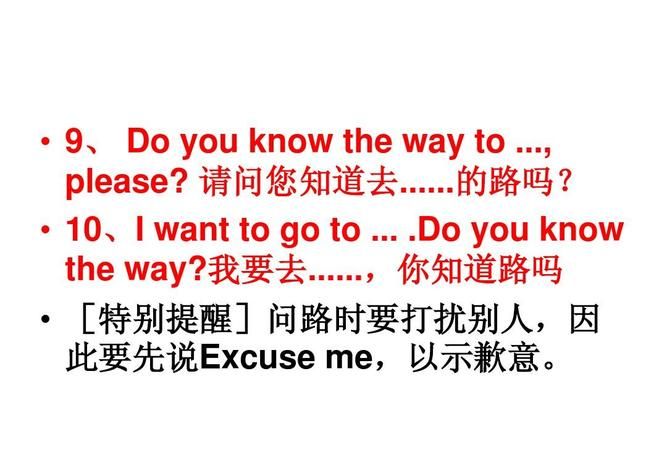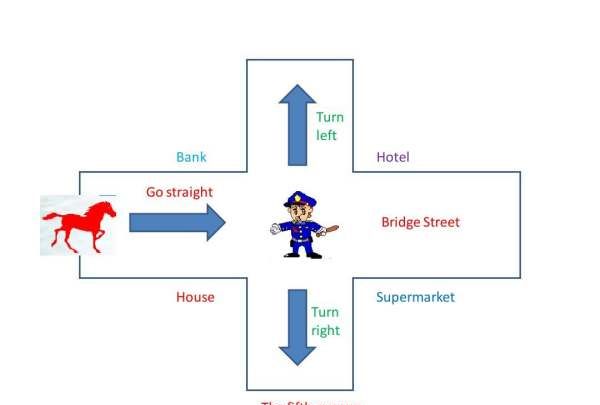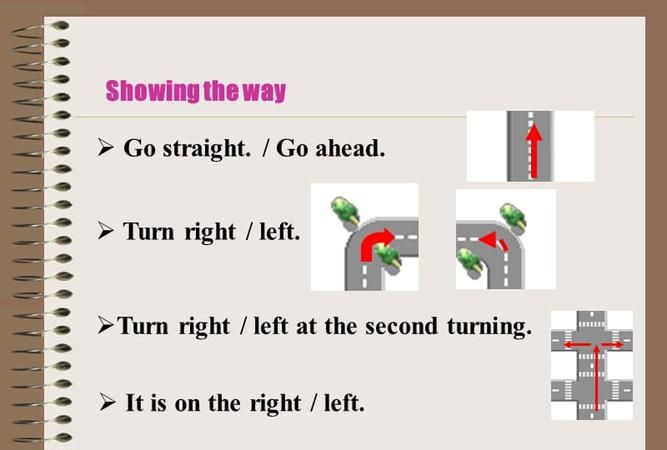本文目录
有礼貌的问路方式英语
①Excuse me,could you tell me the way to ...
②Excuse me,where is ...please?
③Excuse me,how can i get to...
④Excuse me,is there a/an...near here?
⑤Excuse me,which is the way to...
⑥Excuse me,would you please show me the way to ...
⑦Excuse me,would you mind telling me the way to ...
⑧Excuse me,I wonder if you could do me a favor,I'm looking for...
⑨

问路的常用句型英语5种
问路的常用英文句型:
1、How do I get to…?
去某处该怎么走……?
例句:
①How do I get to the Forbidden City?
我怎么去紫禁城呢?
②How do I get to the National Museum from here?
从这里怎么到国家博物馆?
2、Can you tell me the way to…?
你能不能告诉我去……的路该怎么走?
例句:Can you tell me the way to the post office?
你能告诉我去邮局怎么走吗?
3、Where is…?
……在哪儿?
例句:
①Where is the subway station / bus station?
地铁站在哪里?/公交站在哪里?
②Where is the theater?
电影院在哪里?
4、Is there a…near here?
附近有没有……?
例句:
①Is there a hotel near here?
附近有没有酒店?
②Is there a coffee shop near here?
附近有咖啡厅吗?

指路常用英语句型
It's over there.在那边
It's behind the…在…后面
It's next to the…在…旁边
It's in front of the…它就在…前面
It's near the…它在…附近
It's on the right/left of the…它在…右/左边
It's outside the…它在…外面
It's on the other side of the…它在…对面
二、回答Which is the way to…please?和How can I get to…?等问路的对话时,可以根据具体情况,将下列有关句子组织起来用:
1、Walk along this road/street.
沿着这条路/街走。
2、It's about…meters from here.
从这里大约…米。
3、Take the lst/…turning on the left/right.
在第…个转弯处左/右转。
4、It's about…meters along on the right/left.
沿右边/左边大约…米。
5、Walk on and turn left/right.
继续走再向左/右转。
6、Turn right/left at the traffic lights. You\'ll find the…on the right/left.
在交通灯右/左转,你会发现……在右/左边。
有关问路和指路的英语句子表达
一、问路
①Excuse me,can you tell me where the railway station is?
打扰一下,请问火车站在哪儿?
②Excuse me,but can you tell me the way to the train station?
劳驾,请问去火车站怎么走?
③Excuse me,could you tell me which is the way to the nearest hospital?
劳驾,请问去最近的医院怎么走?
④Excuse me,would you please show me the way to the post office?
请告诉我去邮局怎么走好吗?
⑤Excuse me,would you mind telling me the way to the police station?
劳驾,请告诉我去警察局怎么走好吗?
⑥Excuse me,how can I get to No.1 Middle School?
劳驾,请问去一中怎么走?
⑦Excuse me,is this the right way to the People’s Park?
打扰了,请问去人民公园走这条路对吗?
⑧Excuse me.Could you tell me if there is a Qiaotou Middle School near here?
打扰了,请问桥头中学是否在这附近?
⑨Excuse me.Do you know how I can get to Qiaotou Middle School?
=Excuse me.Do you know how to get to Qiaotou Middle School?
请问,你知道怎样去桥头中学吗?
二、指路
①Go straight down this street about five blocks,and you'll see a drugstore on the corner.When you get there,turn right.You'll see it just on your left.
沿着路往下走5个街区,你会看到一家药店在街角。当你到达那里后,向右转。你会看到店就在你的左手边。
②Look,walk down this street for 3 blocks.Then turn right at Pennsylvania Avenue.Go straight until you see the second traffic light.And you'll find the pizza shop.It’s on the left-hand side of the avenue.
看,沿着路往下走3个街区,在宾夕法尼亚大街向右转。一直往前走,直到你看到第二个红绿灯。你会看到披萨店在路的左边。

扩展资料
注意事项
①问路时应首先说一声:“Excuse me.”这样可以引起对方的注意,又不失礼貌。
②当你没听清时,你可以说一声“Excuse me,would you please say it again?”(对不起,请您再说一遍好吗?)或“I beg your pardon?”(对不起,请再说一遍好吗?)等,礼貌地要求对方重复一遍。
③问完路后,千万不要忘记向对方说句“Thank you for helping me.”或“Thank you.”
④问路时经常会用到“向左(右)拐”这样的表达,英语对此有两种常见的说法,即turn left(right)或turn to the left(right)。表示“在左(右)边”,英语用介词on或at均可。
6个问路时常用的英语表达句型是
春暖花开的日子最适合出去旅游。但是在国外旅行的时候,你需要知道怎么问路的英语句型。下面是我为您收集整理的问路时常用的`英语表达句型,欢迎阅读!
1、Remember to be polite when asking for directions, and don’t forget to say “thank you”!
问路的时候切记一定要礼貌,不要忘记说“谢谢”。
2、“How do I get to …” – This is the simplest way to ask someone for directions. When you use this phrase, the other person will either tell you which mode of transport (bus, underground) to take or will explain your route.
“我该怎么去…”这是向他人问路最简单的说法。当你用这个短语的时候,别人也会告诉你选择哪种交通工具到目的地(公交车,地铁)或者告诉你清楚的路线。
3、“Could you tell me the best way to get to …” – This is a very polite way to ask for directions.
“你能告诉我去…最好的方式吗”这是非常礼貌的问路方式。
4、“Where exactly am I?” – Now, if you are travelling to an English speaking country and you ask for directions, you still might get lost. And in order to get new directions, you might need to find out where exactly you are, for example which street you are on. If this is the case, ask this particular question.
“我现在的到底在哪?”—此刻,如果你在一个讲英语的国度旅行并问路时,你可能仍然会迷路。为了得到新的方向,你可能需要找出你现在所在的具体位置,例如你在哪条街。如果是这样的情况,就用这个特别的方式问路。
5、“What is the quickest way to get to …” – Let’s pretend you have to catch a bus and this bus comes at certain times in the day. So you need to get to the bus stop quickly. If you need to go somewhere fast, ask this question.
“到…最快的方式是什么”—让我们假设你要搭乘的一辆公共汽车,而一天就只有几趟,因此你需要迅速的去公交车站台。如果你需要迅速的去某地,就用这个方式来问。
6、“Where is …” – This phrase is also useful when asking for directions. I use this phrase mostly with “Where is the bathroom?” Usually, this phrase is used when you know you are very close to your destination, you just need a little guidance in finding the place.
“…在哪里”—这个短语在问路的时候也很有用。我大多数时候用这个短语问“洗手间在哪里?”。通常,这个短语用在你已经知道你离你的目的地很近了,只需要稍微指点一下。

以上就是关于礼貌问路的英语句型,有礼貌的问路方式英语的全部内容,以及礼貌问路的英语句型 的相关内容,希望能够帮到您。

